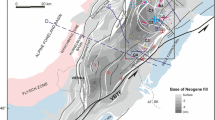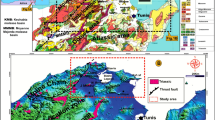Abstract
Subsidence and thermal history analysis are carried out in order to investigate the Cenozoic basin development of the southwestern (Tenggol Arch and basinal side) part of the Malay basin. Structurally, the southwestern part consists of normal faults and horst and graben geometry. Tectonic subsidence curves show that the basinal side is more active than the Tenggol Arch due to movement along normal faults. Cenozoic development initiated with the deposition of sedimentary Units M & L (Oligocene) and the activation of the Tenggol fault on the basinal side. Several periods of accelerated and slow subsidence are observed during the Oligocene to Middle Miocene that could be associated with changes in regional stresses caused by pulsating plate movement. The Malay Basin experienced inversion throughout the Middle to Late Miocene related to mantle induced slab avalanche effect, causing relatively higher tectonic subsidence rates on the Tenggol Arch compared to the basinal side, suggesting that the Tenggol Arch is less affected by inversion than the basinal side. After a period (Late Miocene) of non-deposition, the basin was reactivated (Pliocene to recent) due to thermal relaxation with thick sedimentation. Paleo heat flows estimated utilizing a novel technique introduced in this study and present day heat flow calibrated using BHT data further supports our results, in that increase in heat flow is related to rapid tectonic subsidence. An anomalously high heat pulse affected the basin during inversion and could be the cause of meta-sediment formation whereas present heat flows, although high compared to average basins, shows decreasing trend from the inversion period.
















Similar content being viewed by others
Abbreviations
- BHT:
-
Bottom hole temperature
- Vro:
-
Vitrinite reflectance
- FAMM:
-
Florescence alteration of the multiple macerals
- DST:
-
Drill stem test
- TSR:
-
Tectonic subsidence rates
- LSR:
-
Loading subsidence rates
- TVDSS:
-
True vertical depth subsea
- Sh:
-
Shale
- Sst:
-
Sand stone
- Sltst:
-
Silt stone
- TOC:
-
Total organic carbon
- HI:
-
Hydrogen Index
References
Al-Hajeri MM, Al Saeed M, Derks J, Fuchs T, Hantschel T, Kauerauf A, Neumaier M, Schenk O, Swientek O, Tessen N (2009) Basin and petroleum system modeling. Oilfield Review 21:14–29
Allen PA, Allen JR (2005) Basin analysis–principles and applications, 2nd edn. Blackwell Publishing, Oxford
Angermann D, Wilson R (1999) Observing plate motions in SE Asia: geodetic results of the GEODYSSEA project. Geophys Res Lett 26:2081–2084
Athy LF (1930) Density, porosity, and compaction of sedimentary rocks. AAPG Bull 14:1–24
Barton P, Wood R (1984) Tectonic evolution of the North Sea basin: crustal stretching and subsidence. Geophys J Int 79:987–1022
Bertrand G, Rangin C, Maluski H, Han TA, Thein M, Myint O, Maw W, Lwin S (1999) Cenozoic metamorphism along the Shan scarp (Myanmar): evidences for ductile shear along the Sagaing fault or the northward migration of the eastern Himalayan syntaxis. Geophys Res Lett 26:915–918
Bond GC, Kominz MA (1984) Construction of tectonic subsidence curves for the early Paleozoic miogeocline, southern Canadian Rocky Mountains: implications for subsidence mechanisms, age of breakup, and crustal thinning. Geol Soc Am Bull 95:155–173
Burnham AK, Sweeney JJ (1989) A chemical kinetic model of vitrinite maturation and reflectance. Geochim Cosmochim Acta 53:2649–2657
Cardwell RK, Isacks BL (1978) Geometry of the subducted lithosphere beneath the Banda Sea in eastern Indonesia from seismicity and fault plane solutions. Jo Geophys Res: Solid Earth 83:2825–2838
Catuneanu O (2006) Principles of sequence stratigraphy. Elsevier, Amsterdam
Chapman RE (2000) Petroleum geology, vol 16. Elsevier, Amsterdam
Clendening JA, McCown MW (1999) Swan creek field: potential giant develops in East Tennessee. Oil & gas journal 97:95–99
Cooper M, Williams G, De Graciansky P, Murphy R, Needham T, De Paor D, Stoneley R, Todd S, Turner J, Ziegler P (1989) Inversion tectonics—a discussion. Geol Soc Lond Spec Publ 44:335–347
Cunha T (2008) Gravity anomalies, flexure and the thermo-mechanical evolution of the West Iberia margin and its conjugate of Newfoundland. D. Phil thesis, University of Oxford. 383pp
Dowdle W, Cobb W (1975) Static formation temperature from well logs—an empirical method. J Pet Technol 27(1):326–321 330
Fyhn MB, Nielsen LH, Boldreel LO (2007) Cenozoic evolution of the Vietnamese coastal margin. Geol Survey Denmark Greenland Bull 13:73–76
Gosnold W, Panda B (2002) The global heat flow database of the international heat flow commission. (http://www.und.edu/org/ihfc/index2.html)
Hall R (2012) Late Jurassic–Cenozoic reconstructions of the Indonesian region and the Indian Ocean. Tectonophysics 570:1–41
Hall R, Morley CK (2004) Sundaland basins. Continent-ocean interactions within East Asian marginal seas: 55–85
Hall R, Nichols G (2002) Cenozoic sedimentation and tectonics in Borneo: climatic influences on orogenesis. Geol Soc Lond Spec Publ 191:5–22
Hall R, van Hattum MW, Spakman W (2008) Impact of India–Asia collision on SE Asia: the record in Borneo. Tectonophysics 451:366–389
Hanschel T, Kauerauf A (2009) Fundamentals of basin and petroleum systems modelling. Springer-Verlag, Berlin-Heidelberg 129p
Haq BU, Hardenbol J, Vail PR (1987) Chronology of fluctuating sea levels since the Triassic. Science 235:1156–1167
Hutchison CS (1989) Geological evolution of south-east Asia, vol 13. Clarendon Press Oxford, Oxford
Ismail M, Rudolph K, Abdullah S (1994) Structural and sedimentary evolution of the Malay Basin. AAPG Bulletin 78
Johnston C, Bowin C (1981) Crustal reactions resulting from the mid-Pliocene to recent continent-island arc collision in the Timor region. BMR J Aust Geol Geophys 6:223–243
Kominz MA, Patterson K, Odette D (2011) Lithology dependence of porosity in slope and deep marine sediments. J Sediment Res 81:730–742
Kus J, Cramer B, Kockel F (2005) Effects of a cretaceous structural inversion and a postulated high heat flow event on petroleum system of the western lower Saxony Basin and the charge history of the Apeldorn gas field. Neth J Geosci 84:3–24
Lerche I, Yarzab R, Kendall CSC (1984) Determination of paleoheat flux from vitrinite reflectance data. AAPG Bull 68:1704–1717
Madon M (1992) Depositional setting and origin of berthierine oolitic ironstones in the lower Miocene Terengganu Shale, Tenggol Arch, offshore peninsular Malaysia. J Sediment Res 62
Madon M (1997) Analysis of tectonic subsidence and heat flow in the Malay Basin (offshore Peninsular Malaysia). Bull Geol Soc Malaysia 41:95–108
Madon M (2007) Overpressure development in rift basins: an example from the Malay Basin, offshore Peninsular Malaysia. Pet Geosci 13:169–180
Madon M, Watts A (1998) Gravity anomalies, subsidence history and the tectonic evolution of the Malay and Penyu Basins (offshore Peninsular Malaysia). Basin Res 10:375–392
Madon M, Peter A, Jamaal H (1999) The petroleum geology and resources of Malaysia, vol 1. Petroliam Nasional Berhad (PETRONAS), Kuala Lumpur
Madon M, Kim CL, Wong R (2013) The structure and stratigraphy of deepwater Sarawak, Malaysia: implications for tectonic evolution. J Asian Earth Sci 76:312–333
Mansor MY, Rahman AHA, Menier D, Pubellier M (2014) Structural evolution of Malay Basin, its link to Sunda Block tectonics. Mar Pet Geol 58:736–748
Martin J, Nicoletis S, Raiga-Clemenceau J (1988) The concept of acoustic formation factor for more accurate porosity determination from sonic transit time data. Log Anal 29
Michon L, Van Balen RT, Merle O, Pagnier H (2003) The Cenozoic evolution of the Roer Valley Rift System integrated at a European scale. Tectonophysics 367:101–126
Morley RJ (1998) Palynological evidence for tertiary plant dispersals in the SE Asian region in relation to plate tectonics and climate. Biogeography and geological evolution of SE Asia:211–234
Morley CK (2001) Combined escape tectonics and subduction rollback–back arc extension: a model for the evolution of Tertiary rift basins in Thailand, Malaysia and Laos. J Geol Soc 158:461–474
Morley CK (2002) A tectonic model for the Tertiary evolution of strike–slip faults and rift basins in SE Asia. Tectonophysics 347:189–215
Morley CK (2013) Discussion of tectonic models for Cenozoic strike-slip fault-affected continental margins of mainland SE Asia. J Asian Earth Sci 76:137–151
Morley CK, Westaway R (2006) Subsidence in the super-deep Pattani and Malay basins of Southeast Asia: a coupled model incorporating lower-crustal flow in response to post-rift sediment loading. Basin Res 18:51–84
Nazri RM (1988) Stratigraphy and palaeofacies development of Carigali’s operating areas in the Malay Basin, South China Sea. Buletin Persatuan Geologi Malaysia= Bulletin Geological Society of Malaysia 22:153–187
Ngah K, Madon M, Tjia H (1996) Role of pre-Tertiary fractures in formation and development of the Malay and Penyu basins. Geol Soc Lond Spec Publ 106:281–289
Pollack HN, Hurter SJ, Johnson JR (1993) Heat flow from the Earth's interior: analysis of the global data set. Rev Geophys 31:267–280
Ramli N (1988) Development of a humid, tropical fan-delta system: the middle Tertiary'K'Sandstone in the southeastern Malay Basin, offshore West Malaysia. Fan Deltas: Sedimeutology and Tectonic Settings: Glasgow, Blackie:341–353
Ratanasthien B (2002) Problems of Neogene biostratigraphic correlation in Thailand and surrounding areas. Revista Mexicana de Ciencias Geológicas 19:235–241
Ridd MF, Barber AJ, Crow MJ The geology of Thailand. In, 2011. Geological Society of London,
Sclater JG, Christie P (1980) Continental stretching; an explanation of the post-mid-cretaceous subsidence of the central North Sea basin. J Geophys Res 85:3711–3739
Shahar S (2008) Structural evolution of the Tenggol Arch and its implication for basement fracture patterns in the Malay Basin. Durham University, Durham
Songtham W (2000) Palynology of Na Hong basin Amphoe Mae Chaem Changwat Chiang Mai, Thailand. Chiang Mai University, Chiang Mai
Steckler M, Watts A (1978) Subsidence of the Atlantic-type continental margin off New York. Earth Planet Sci Lett 41:1–13
Tagiyev M, Nadirov R, Bagirov E, Lerche I (1997) Geohistory, thermal history and hydrocarbon generation history of the north-west South Caspian Basin. Mar Pet Geol 14:363–382
Thorne JA, Watts AB (1989) Quantitative analysis of North Sea subsidence. AAPG Bull 73:88–116
Tissot B, Welte D (1978) Petroleum formation and occurance: a new approach to oil and gas exploration. Springer
Tjia H (2010) Growing evidences of active deformation in the Malay basin region. Geol Soc Malaysia Bull 56:35–40
Van Hinte J (1978) Geohistory analysis—application of micropaleontology in exploration geology. AAPG Bull 62:201–222
Waples D, Ramily M, Leslie W (1995) Implications of vitrinite-reflectance suppression for the tectonic and thermal history of the Malay Basin. Geol Soc Malaysia Bull 37:269–284
Watts A (1982) Tectonic subsidence, flexure and global changes of sea level. Nature 297:469–474
Watts A, Ryan W (1976) Flexure of the lithosphere and continental margin basins. Tectonophysics 36:25–44
Weber V, Maximov S (1976) Early diagenetic generation of hydrocarbon gases and their variations dependent on initial organic composition: GEOLOGIC NOTES. AAPG Bull 60:287–293
Yakzan AM, Awalludin H, Bahari M, Morley R (1996) Integrated biostratigraphic zonation for the Malay Basin. Bull Geol Soc Malaysia 39:157–184
Yang T, Gurnis M, Zahirovic S (2016) Mantle-induced subsidence and compression in SE Asia since the early Miocene. Geophys Res Lett 43:1901–1909
Yusoff WIW (1993) Geothermics of the Malay basin, offshore Malaysia. Durham University, Durham
Acknowledgements
The authors gratefully thank PETRONAS Carigali and Petroleum Management Unit (PMU), Malaysia for granting access to the geophysical and well data. Schlumberger are thanked for providing licenses to their software (Petrel© and PetroMod©). We thank the two anonymous reviewers and the editor-in-chief for their constructive comments that helped to improve the manuscript. Muhammad Hassaan was funded by a postgraduate scholarship from Universiti Teknologi PETRONAS, Malaysia and has received additional support through the Short Term Internal Research Fund (STIRF). While the industry sponsor (PETRONAS) supported this research at the Center of Basin Studies, Universiti Teknologi PETRONAS, Malaysia. However, the technical contents and ideas presented herein are solely the authors’ interpretations. The authors are grateful to PETRONAS PMU for permission to publish this paper.
Author information
Authors and Affiliations
Corresponding author
Ethics declarations
Conflict of interest
The authors declare that they have no conflict of interest.
Rights and permissions
About this article
Cite this article
Hassaan, M., Bhattacharya, S.K., Mathew, M.J. et al. Cenozoic development of southwestern Malay Basin: new insights from subsidence analysis and thermal history. Arab J Geosci 10, 192 (2017). https://doi.org/10.1007/s12517-017-2971-7
Received:
Accepted:
Published:
DOI: https://doi.org/10.1007/s12517-017-2971-7




